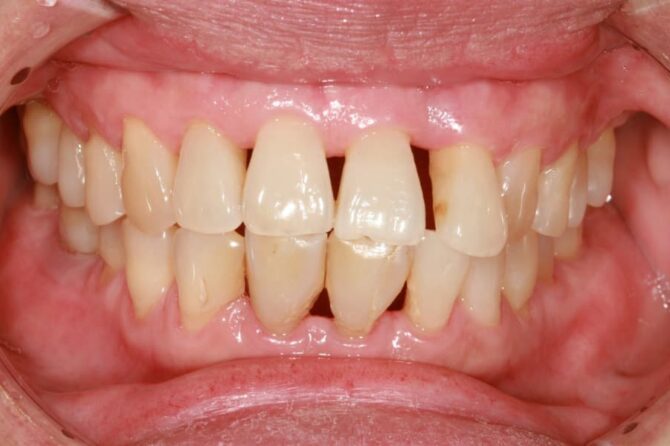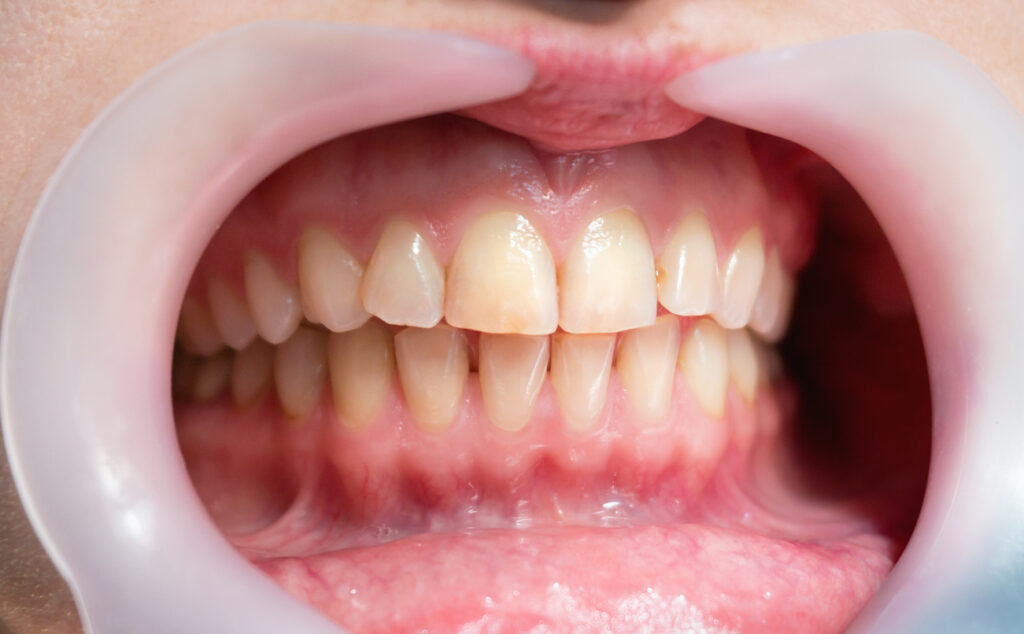
Gain Back Healthy Gums Through These Treatment Options
“Receding gums can be a scary diagnosis – but that doesn’t mean it’s a life sentence. In this guide, we explain what receding gums are, the different treatments available, and how to care for your gums so that you can keep them strong and healthy. Receding gums or “Gingival recession” is when part of the gum tissue surrounding the teeth pulls away, exposing the roots. This can be a sign of an underlying problem like periodontal disease or brushing too hard. Fortunately, there are a variety of treatments and lifestyle changes that can help treat the condition and maintain healthy gums. The goal of this guide is to provide you with the information you need to understand receding gums, the treatments available, and how to prevent and manage the condition. We’ll also look at the benefits and risks associated with each treatment option, so you can make an informed decision about your oral health. At the end of this guide, you’ll have the tools you need to keep your gums healthy and protected from further damage.

What Are Receding Gums?
Receding gums, otherwise known as gingival recession, is a condition in which the gum tissue surrounding the teeth begins to pull away or shrink. The cause of receding gums can be attributed to a range of factors, including periodontal disease, improper dental hygiene, genetics, and aging.
Neglecting proper dental care, such as regular brushing and flossing, is a major contributor to receding gums, as it leads to the accumulation of plaque and tartar and can result in infection and inflammation of the gums. Other causes include brushing too hard, teeth grinding, poor nutrition, smoking and tobacco use, and certain medications.
The effects of receding gums can range from mild discomfort to severe pain. In extreme cases, it can lead to tooth loss, due to the lack of stability caused by the shrinking of the gums. Additionally, it can cause bad breath, gum sensitivity, and an increased risk of developing serious oral health issues.
Receding gums can be embarrassing and uncomfortable, but there are some natural remedies that can help to treat this condition. While professional treatment options are available, many people prefer to treat their receding gums with natural remedies or lifestyle changes. To help improve gum health and prevent receding gums, it is important to practice good oral hygiene. Brushing and flossing your teeth at least twice a day can help remove plaque and bacteria that can cause gums to recede. Additionally, using a soft-bristled toothbrush and toothpaste that contain fluoride can help protect the delicate tissues in your mouth. You should also avoid smoking, as smoking can accelerate the loss of gum tissue. In addition to brushing and flossing, taking regular vitamin supplements can provide additional protection against receding gums. Vitamin C and calcium are especially beneficial for maintaining healthy gums, as they can strengthen the tissue and reduce inflammation. Eating foods rich in these vitamins and minerals, such as oranges, broccoli, dairy products, and fish, can also help prevent receding gums. Using natural remedies to improve your oral health can also help to treat receding gums. Coconut oil, for example, is an effective natural remedy for improving gum health. Using a teaspoon of coconut oil for oil pulling every morning can help to reduce inflammation and prevent gums from receding. Aloe vera gel is another natural remedy that can help soothe the gums and reduce swelling. Finally, reducing stress and getting enough sleep can also help to treat receding gums. Stress can weaken the immune system, leading to a higher risk of gum disease. Getting enough rest can help to keep your immune system functioning optimally and reduce inflammation. By following these simple tips and incorporating natural remedies into your daily routine, you can help to prevent and treat receding gums. When it comes to treating receding gums, there are a few professional treatment options available. One of the most common treatments is deep cleaning, or scaling and root planing. This treatment involves the removal of plaque and calculus buildup below the gumline, which can cause the gums to recede. The dentist or hygienist may also use special tools, such as dental lasers, to remove any infected tissue from the gum line. For more advanced cases, the dentist may recommend flap surgery. This procedure involves lifting the gums and eliminating any infection before repositioning them properly over the teeth. Another treatment option is gingival grafts, which are used to help restore the gumline by replacing missing tissue. The dentist will take a small amount of tissue from another area of your mouth and attach it to the receded area of the gum line. Finally, for severe cases of gum recession, pocket reduction surgery may be recommended. During this procedure, the dentist will attempt to reduce the space between the teeth and gums, helping to stop any further damage. The dentist may also use a laser to remodel and reshape the gums. No matter which treatment option is chosen, it is important to maintain good oral hygiene practices in order to ensure the health of the gums. Brushing and flossing regularly, and visiting the dentist every six months for a professional cleaning, can help maintain the health of the gums and prevent further damage. Pocket reduction surgery is a procedure used to treat receding gums by reducing the depth of the pockets between the gums and teeth. These pockets form due to gum disease and can cause gums to recede, leading to discomfort and sensitivity. The purpose of pocket reduction surgery is to reduce the depth of these pockets and promote healthier gums. The procedure begins with a local anesthetic being used to numb the area. A small incision will then be made in the gum tissue so that the dentist can access the root of the tooth and reduce the pocket depth. During this process, the dentist may also use special instruments to remove plaque and tartar from below the gum line. Once this is complete, stitches may be used to hold the gums in place and encourage healing. In some cases, the dentist may also use special materials to reinforce the gum tissue or create a better shape for the tooth and gums. After the procedure, the patient’s gums will be monitored for signs of infection and healing. It is important for patients to practice good oral hygiene after the procedure to prevent infection and ensure successful healing. Pocket reduction surgery can be an effective treatment for receding gums and can help to reduce the pocket depth and promote healthier gums. While it is not a permanent solution, it can provide relief from discomfort and sensitivity and help protect against further damage. Periodontal plastic surgery is an increasingly popular option for treating receding gums. This type of surgery is a gum reshaping procedure that aims to restore the natural gumline and improve the appearance of your smile. During the procedure, your dental surgeon will use specialized tools and techniques to trim away excess gum tissue and reshape the gum line so that it looks more even and symmetrical. The goal is to reduce the visibility of any receding areas and improve the overall look of your smile. Periodontal plastic surgery can be a great choice for those with severe gum recession, as it offers quick and long-lasting results. While the procedure itself is relatively straightforward and non-invasive, there are still some potential risks involved, such as bleeding, infection, and nerve damage. Therefore, it is important to consult with a qualified dentist or periodontist before deciding if this type of treatment is right for you. During the procedure, your dentist will first numb the area with a local anesthesia. They will then use scissors, a scalpel, or a laser to carefully trim away excess gum tissue. Depending on the severity of your gum recession, they may also use special bonding agents or surgical stapling to keep the gums in their new shape. After the procedure is finished, you will likely experience some discomfort and swelling, but these symptoms should fade over time. Finally, your dentist may recommend that you use a special mouthwash or antibacterial treatment after the procedure to prevent infection and help with healing. Be sure to follow all instructions that your dentist provides and contact them immediately if you experience any unexpected side effects. Soft-tissue grafting surgery is a procedure that is used to treat receding gums. It is a type of periodontal plastic surgery that can help restore the gum line and protect the roots of the teeth. The goal of the procedure is to cover the exposed surface of the roots and stop further deterioration of the gum tissue. The procedure involves the use of soft tissue harvested from the roof of the mouth and grafted onto the affected areas. The donor tissue is then stitched into place to provide a better seal and create a strong bond between the old and new tissue. This helps to reduce gum recession and strengthen the existing gums. Soft-tissue grafting surgery is usually done as an outpatient procedure under local anaesthesia. During the surgery, the damaged gums will be trimmed away and the graft tissue secured with stitches. It is important to follow the post-operative instructions given by the surgeon, including taking medications prescribed and avoiding strenuous activities for a few weeks. The results of soft-tissue grafting surgery are usually very good, and the procedure can help to restore the appearance of the smile and prevent further gum recession. However, it is important to note that the procedure does not guarantee permanent results and that some patients may require additional treatments to maintain the results. It’s important to take steps to prevent and manage receding gums, which can cause long-term damage to your teeth and gums. There are a variety of treatments available, ranging from simple lifestyle changes to more complex surgical procedures. Here are some tips on how you can help keep your gums healthy:
- Practice good oral hygiene: Brushing twice a day with fluoride toothpaste and flossing daily will help remove plaque and tartar buildup from your teeth, reducing the risk of receding gums.
- Avoid smoking: Smoking can contribute to gum recession by damaging the tissue and reducing blood flow to your gums.
- Maintain a balanced diet: Eating a healthy, balanced diet can help promote gum health and reduce inflammation.
- Use a soft-bristled toothbrush: Soft-bristled toothbrushes are gentler on your gums, reducing the risk of further damage.
- Visit your dentist regularly: Regular checkups with your dentist are important to monitor the health of your gums and detect any signs of gum recession early.
These tips can help you prevent and manage receding gums, and may even reverse the damage if caught in the early stages. However, it is important to speak to your dentist to discuss the best treatment plan for your individual needs. When considering the treatments available for receding gums, it is important to take into account their benefits as well as their risks. Receding gums treatments can help to restore the gum line, improve oral health, and reduce pain and inflammation associated with gum recession. However, while these treatments are generally safe and effective, they can also cause some side effects. It is important to research each treatment before making a decision and discuss any concerns with a dentist or periodontist. Natural remedies, such as oil pulling, can help to reduce the symptoms of receding gums and help to promote healthy gums. These treatments are generally safe and come with minimal risks. Oil pulling has been shown to reduce plaque build-up, inflammation and gingivitis. It can also help to reduce bacteria in and around the mouth. Professional treatments for receding gums, such as pocket reduction surgery and periodontal plastic surgery, can be more effective than natural remedies at treating gum recession, but they also carry more risks. Pocket reduction surgery helps to remove infected tissue and minimize the pocket between the tooth and gum, while periodontal plastic surgery can reshape gums to improve the appearance of the teeth and reduce the risk of further gum recession. Soft-tissue grafting surgery is an invasive treatment used to restore lost gum tissue. While this procedure can result in a more even gum line and improved oral health, there are potential risks associated with this method, such as pain, bleeding, swelling and infection. It is important to weigh the benefits and risks of any receding gums treatments before making a decision. It is also important to implement preventative measures such as brushing twice daily using a soft-bristled toothbrush, flossing regularly and visiting the dentist for regular cleanings and check-ups to help reduce the risk of gum recession. Receding gums can be an embarrassing and uncomfortable condition to live with. It can cause discomfort, pain, or even tooth loss. However, there are steps that can be taken to help alleviate the symptoms of receding gums and even stop it getting worse. In this guide, we will discuss the definition of receding gums, natural remedies, professional treatments, pocket reduction surgery, periodontal plastic surgery, and soft-tissue grafting surgery. We will also take a look at tips for preventing and managing receding gums, and the benefits and risks associated with receding gums treatments. We hope that this guide can provide readers with more information on receding gums and how to treat it. After reading this guide, you should have a better understanding of the condition and know the steps you can take to improve your oral health. With the right treatments, it is possible to find relief from the symptoms of receding gums, so don’t hesitate to seek out professional help if necessary. The key takeaway from this guide is to be aware of the signs and symptoms of receding gums, as well as the treatments that can help manage and prevent it. Following the recommended natural remedies and professional treatments outlined in this guide can help to keep your gums healthy and protect them from further damage. There are risks associated with receding gum treatments that should be discussed with a health care professional before undergoing treatment. Remember to use quality products, maintain good oral hygiene, and visit the dentist regularly for optimal gum health. When it comes to optimizing your content for search engines, using the right keywords is essential. For this guide on receding gums treatment, the target search terms are “receding gums treatment.” In addition, other relevant keywords could include “gum recession,” “gum disease,” “periodontal surgery,” and “natural remedies for receding gums.” Using these keywords in the article and description can help improve visibility and overall ranking on search platforms. “
FAQs About Receding Gums Treatment
- Q: What is receding gums?
A: Receding gums is a condition of recession, meaning that the gum tissue around the teeth pull away, or recede, exposing more of the tooth. This can cause pain, sensitivity and even tooth loss if left untreated. - Q: What are the causes of receding gums?
A: The primary causes of receding gums include dental diseases such as periodontitis and gingivitis, as well as over-brushing, aggressive flossing, age, smoking and hormonal changes. - Q: What are the natural remedies for receding gums?
A: Natural remedies for receding gums include oil pulling, regularly brushing with neem toothpaste, consuming products high in vitamin D, avoiding sugary drinks and foods, using a soft bristled toothbrush, and rinsing with salt water and tea tree oil. - Q: What are the professional treatment options available?
A: Professional treatment options for receding gums include pocket reduction surgery, periodontal plastic surgery and soft-tissue grafting surgery. - Q: What is pocket reduction surgery?
A: Pocket reduction surgery works to remove the bacteria-harboring plaque and calculus that has built up in the area between the teeth and the gums to reduce inflammation and improve the overall health of the gums. - Q: What is periodontal plastic surgery?
A: Periodontal plastic surgery is a regenerative procedure that involves the reshaping and contouring of the existing gum tissue to restore the gums back to its former healthy state. - Q: What is soft-tissue grafting surgery?
A: Soft-tissue grafting surgery is a procedure in which a small sample of healthy gum tissue is taken from another area of the mouth and then transplanted to the site of the receding gums to help promote regrowth and decrease further recession.
